基于MPPT控制的光伏发电系统设计_本科毕业设计(论文)
MPPT控制算法太阳能充放电控制器设计---新能源

错误!未找到引用源。
毕业论文论文题目MPPT控制算法太阳能充放电控制器设计系(部)电力工程系学科专业新能源应用技术班级错误!未指定书签。
姓名阿卜杜热伊木学号 2011232560 指导教师刘华二〇一四年四月二十八日新疆工程学院毕业论文任务书新疆工程学院毕业论文成绩表目录摘要 (6)Abstract (7)第一章引言 (10)1.1本课题的选题背景和来源 (10)1. 2太阳能光伏发电简介 (11)1.2.1太阳能光伏发电系统 (11)1.2.2独立太阳能系统的构成 (11)1.3国内外太阳能发电的现状 (11)1.4光伏太阳能控制器国内外现状 (12)1.5论文意义 (12)1.6论文的主要研究内容 (13)第二章光伏发电系统中太阳能电池的特性与应用 (14)2.1太阳能电池的结构及工作原理 (14)2.1.1太阳能电池的结构 (14)2.1.2太阳能电池的工作原理 (14)2.2太阳能电池的特性及应用 (14)2.3本章小结 (15)第三章蓄电池 (16)3.1蓄电池的简介 (16)3.1.1蓄电池的介绍 (16)3.1.2蓄电池技术参数 (16)3. 1. 3蓄电池特性²²²²²²²²²²²²²²²²²²²²²²²²²²²²²²²²²²²²²²²²²²173.2蓄电池的工作原理 (19)3.3蓄电池的充电技术 (20)3.4本章小结 (22)第四章光伏太阳能发电系统中MPPT技术的实现 (23)4.1光伏太阳能发电系统中的最大功率点跟踪 (23)4. 1. 1什么是MPPT²²²²²²²²²²²²²²²²²²²²²²²²²²²²²²²²²²²²²²²²²²24 4. 2充电算法及实现²²²²²²²²²²²²²²²²²²²²²²²²²²²²²²²²²²25 4. 2. 1 充电控制算法²²²²²²²²²²²²²²²²²²²²²²²²²²²²²²²²²²²²²²²25 4. 2. 2 MPPT充电算法实现²²²²²²²²²²²²²²²²²²²²²²²²²²²²²²²²²²²27 4.3最大功率跟踪控制的常用方法 (28)4.3.1恒压跟踪法 (28)4.3.2扰动观察法 (28)4.3.3增量电导法 (28)4. 3.4模糊逻辑控制法 (29)4. 4充电控制器的控制略²²²²²²²²²²²²²²²²²²²²²²²²²²²²²²²29 4.5控制算法的分析和选择²²²²²²²²²²²²²²²²²²²²²²²²²²²²30 4. 6太阳能发电系统效率分析²²²²²²²²²²²²²²²²²²²²²²²²²²314. 6. 1系统整体结构设计²²²²²²²²²²²²²²²²²²²²²²²²²²²²²²²²²²²²32 4. 6. 2太阳能控制器结构²²²²²²²²²²²²²²²²²²²²²²²²²²²²²²²²²²²²324.7本章小结 (33)第五章小型太阳能光伏控制器硬件和软件的设计 (34)5.1控制器系统的简介 (34)5.2硬件电路设计 (34)5.2.1太阳能光伏充电控制器 (34)5.2.2系统供电电源 (36)5.2.3太阳能电板输入电流采样电路 (37)5.2.4蓄电池放电控制电路 (39)5.2.5蓄电池过充过放检测电路 (39)5.2.6控制系统显示电路 (40)5.3软件设计 (40)5. 3. 1 A/D转换程序设计 (41)5.3.2最大功率点跟踪控制程序设计 (42)5.3.3充电控制程序 (42)5.4系统的可靠性分析及设计 (43)5.4.1硬件的可靠性设计 (43)5.4.2软件的可靠性设计 (44)5.5本章小结 (44)第六章系统数据分析 (45)6.1系统结果分析 (45)6.2本章小结 (46)总结 (48)致谢 (49)参考文献 (50)MPPT控制算法太阳能充放电控制器设计摘要:太阳能光伏发电现已成为新能源和可再生能源的重要组成部分,也被认为是当前世界最有发展前景的新能源技术。
基于MPPT技术的光伏路灯控制系统硬件设计

1 引言1.1 太阳能光伏发电的背景及意义随着社会生产的日益发展,能源的地位愈发重要。
在20世纪的世界能源结构中,人类所利用的一次能源主要是石油、天然气和煤炭等化石能源。
这些化石能源本质上是数万年甚至更长时间以来太阳能辐射到地球上的一部分能源储存到古生物中,经过人类数千年,特别是近百年的消费,这些化石能源已被消耗了相当比例。
随着经济的发展、人口的增加和社会生活水平的提高,未来世界能源消费量将持续增长,世界上的化石能源消费总量总有一天将达到极限[1]。
此外,大量使用化石燃料已经为人类生存环境带来了严重的后果。
目前由于大量使用矿物能源,全世界每天产生约1亿吨温室效应气体,己经造成极为严重的大气污染。
如果不加控制,温室效应将融化两极的冰山,这可能使海平面上升几米,四分之一的人类生活空间将由此受到极大威胁。
当前人类文明的高度发展与地球生存环境的快速恶化己经形成一对十分突出的矛盾。
它向全世界能源工作者提出了严峻的命题和挑战[2]。
1.1.1 世界能源危机和太阳能的利用社会的发展,对能源的要求也越来越大。
以往人类所用的能源主要是包括石油、天然气在内的化石能源,这些能源是经过数万年甚至更长的时间由古生物的遗体演变而成,储存在地球上的能源矿藏。
这些能源虽然从本质上也是来源于太阳能,但是由于它们的积累需要经过漫长的地质年代,所以属于不可再生能源。
因此对能源一点点消耗,能源总有一天到枯竭的时候。
经济发展越快,对能源需求越大,能源消耗也就越快。
虽然在可预见的将来,煤炭、石油、天然气等矿物燃料,仍将在世界能源结构中占有相当的比重,但人们对核能以及太阳能、风能、地热能、水力能、生物能等可持续能源资源的利用目益重视,在整个能源消耗中所占的比例正在显著地提高。
据统计,20世纪90年代,全球煤炭和石油的发电量每年增长1%,而太阳能发电每年增长达20%,风力发电的年增长率更是高达26%。
预计在未来5至10年内,可持续能源将能够与矿物燃料相抗衡,从而结束矿物燃料一统天下的局面。
毕业设计(论文)光伏并网发电系统设计
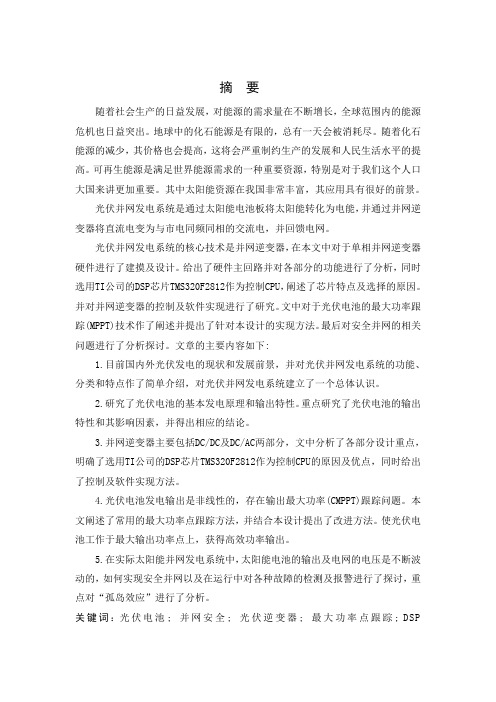
摘要随着社会生产的日益发展,对能源的需求量在不断增长,全球范围内的能源危机也日益突出。
地球中的化石能源是有限的,总有一天会被消耗尽。
随着化石能源的减少,其价格也会提高,这将会严重制约生产的发展和人民生活水平的提高。
可再生能源是满足世界能源需求的一种重要资源,特别是对于我们这个人口大国来讲更加重要。
其中太阳能资源在我国非常丰富,其应用具有很好的前景。
光伏并网发电系统是通过太阳能电池板将太阳能转化为电能,并通过并网逆变器将直流电变为与市电同频同相的交流电,并回馈电网。
光伏并网发电系统的核心技术是并网逆变器,在本文中对于单相并网逆变器硬件进行了建摸及设计。
给出了硬件主回路并对各部分的功能进行了分析,同时选用TI公司的DSP芯片TMS320F2812作为控制CPU,阐述了芯片特点及选择的原因。
并对并网逆变器的控制及软件实现进行了研究。
文中对于光伏电池的最大功率跟踪(MPPT)技术作了阐述并提出了针对本设计的实现方法。
最后对安全并网的相关问题进行了分析探讨。
文章的主要内容如下:1.目前国内外光伏发电的现状和发展前景,并对光伏并网发电系统的功能、分类和特点作了简单介绍,对光伏并网发电系统建立了一个总体认识。
2.研究了光伏电池的基本发电原理和输出特性。
重点研究了光伏电池的输出特性和其影响因素,并得出相应的结论。
3.并网逆变器主要包括DC/DC及DC/AC两部分,文中分析了各部分设计重点,明确了选用TI公司的DSP芯片TMS320F2812作为控制CPU的原因及优点,同时给出了控制及软件实现方法。
4.光伏电池发电输出是非线性的,存在输出最大功率(CMPPT)跟踪问题。
本文阐述了常用的最大功率点跟踪方法,并结合本设计提出了改进方法。
使光伏电池工作于最大输出功率点上,获得高效功率输出。
5.在实际太阳能并网发电系统中,太阳能电池的输出及电网的电压是不断波动的,如何实现安全并网以及在运行中对各种故障的检测及报警进行了探讨,重点对“孤岛效应”进行了分析。
光伏发电系统建模及其仿真(毕业设计论文)

本科生毕业设计说明书(设计论文)题目:光伏发电系统建模及其仿真光伏发电系统建模及其仿真摘要伴随着能源危机和环境问题的不断加剧,清洁能源的发展进程被大大的推进了。
太阳能作为一种新能源以其没有污染,安全又可靠,能量随处可以得到等优点越来越受到人们的青睐.无论从近期还是远期,无论从能源环境的角度还是从边远地区和特殊应用领域需求的角度考虑,太阳能发电都极具有吸引力。
那么对光伏发电系统的研究则就变得既有价值又有意义。
通过对光伏发电系统的理论研究学习,建立了完整的光伏发电系统体系,本文深入的研究了光伏电池在不同光照强度、不同温度下的电压、功率输出特性。
本文的研究重点是光伏发电系统的控制技术,以及在MATLAB/SIMULINK仿真环境下的仿真结果。
讨论了多种最大功率点跟踪方法;且分别讨论学习了在光伏并网和独立发电系统情况下的逆变器和MPPT的控制,并建立了仿真模型,提出了相应的控制策略.且在最后论述了孤岛效应的产生和反孤岛策略,用电压频率检测法完成了孤岛检测与保护。
关键词:光伏电池,逆变器,最大功率点跟踪,孤岛效应, MATLAB仿真AbstractWith the growing energy crisis and environmental problems,clean energy is greatly promote the development process. Solar energy as a new kind of energy for its no pollution,safe and reliable,widely available energy advantages, such as more and more get the favor of people。
No matter from the near future or long-dated and, no matter from the Angle of energy and environment,or from remote areas and special applications demand point of view,solar power generation is extremely attractive。
光伏并网发电模拟装置设计-电气工程及其自动化本科毕业论文(设计)
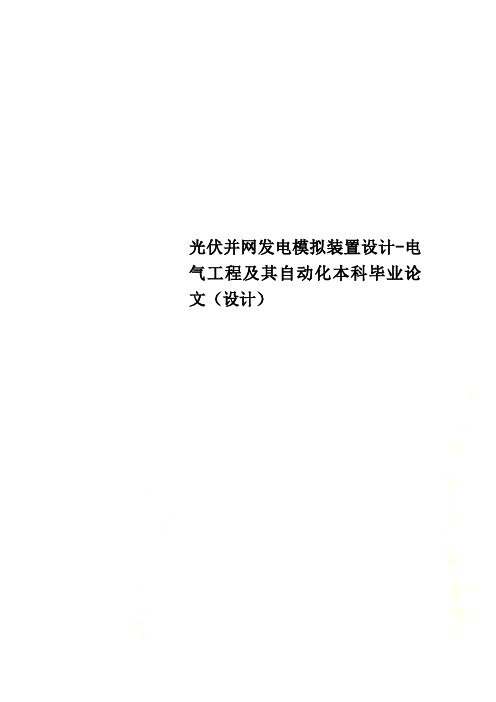
光伏并网发电模拟装置设计-电气工程及其自动化本科毕业论文(设计)xx 学院2015届毕业论文(设计)论文(设计)题目光伏并网发电模拟装置设计子课题题目姓名xxx学号201104170332所属院系自动控制与机械制造学院专业年级电气工程及其自动化3班指导教师xxx2015 年6 月摘要本设计的光伏并网发电模拟装置系统是以 MSP430F169单片机为核心,单片机输出 SPWM 波形经 IR2110驱动 H 桥,实现 DC-AC 逆变的发电模拟装置。
最大功率点跟踪(MPPT)绝对误差小于1%,利用 MSP430F160单片机软件设计实现锁相环,用参考频率作为基准频率,对 MSP430F160单片机的外中断和定时器测定相位,当反馈的电压信号相位滞后(超前)于参考信号的相位时,就增大(减小)SPWM 的频率;达到相位和频率同步。
包括阻性负载,以及非阻性负载,实现了频率跟踪,相位跟踪。
DC-AC 转换效率达 80%,采用LCD 液晶显示器显示,能直观、简洁地显示输出电压、电流,具有良好的人机交互性能。
本文详细阐述了单片机MSP430F169的内部结构,系统硬件电路和软件程序的设计及调试过程以及结果测试,同时给出总体设计的流程图、原理图等。
关键词:光伏并网; MSP430F169; DC-AC ;MPPTAbstractThe design of photovoltaic power generation system simulation device based on MSP430F169 single chip microcomputer, microcontroller SPWM output waveform by IR2110 bridge driver H, DC-AC inverter power generation simulation device. The maximum power point tracking (MPPT) absolute error is less than 1%, to achieve phase-locked loop using MSP430F160 MCU software design, using the reference frequency as the reference frequency, the MSP430F160 MCU interrupt and timer test phase, when the phase voltage signal feedback lag (lead) to the phase reference signal, increase (decrease) the frequency of SPWM to achieve the phase and frequency synchronization. Including resistance load and non resistance load, the frequency tracking and phase tracking. The DC-AC conversion efficiency of 80%, with LCD LCD display, can directly and simply display the output voltage and current, has a good interactive performance..This paper describes the internal structure of the chip MSP430F169, the system hardware and software design and the debugging process and test results, and gives the overall design of the flow chart diagram, etc..Keywords: Photovoltaic ; Msp430F169; DC-AC; MPPT目录第一章前言 (1)第二章选题背景 (1)2.1课题来源及其意义 (1)2.2课题设计的主要内容 (1)第三章光伏并网发电系统模拟装置设计原理 (2)3.1逆变原理 (2)3.2正弦脉宽调制SPWM (6)3.3单相全桥逆变中的SPWM控制 (7)3.4最大功率点跟踪(MPPT) (9)第四章总体规划 (11)4.1系统总体方案的选择 (11)4.2逆变器主电路结构 (11)4.2.1 DC-AC逆变方案论证 (12)4.3正弦逆变器的控制 (13)4.3.1正弦脉宽调制SPWM及驱动电路方案选择 (13)4.4MPPT功能 (13)4.4.1 MPPT 的实现程序流程图 (14)4.5滤波器模块选择论证 (14)4.6滤波参数的计算 (14)4.7频率、相位跟踪方案选择论证 (15)4.7.1频率、相位的控制方法与参数计算 (15)4.8提高效率的方法 (15)第五章系统硬件设计 (16)5.1DC-AC主回路 (17)5.2滤波电路 (17)5.3驱动电路 (18)5.4信号采集及保护电路 (18)5.5精密整流电路 (19)5.6单片机MSP430F169的实现程序流程图 (20)第六章单片机简介 (21)6.1主要部件及其功能 (22)6.2引脚说明 (23)参考文献 (26)附录 (26)谢辞 (27)第一章前言随着人类社会的发展,能源的消耗量正在不断增加,世界上的能源正在日趋枯竭。
基于MPPT的太阳能光伏系统研究

基于MPPT的太阳能光伏系统研究随着环保意识的日益提高,越来越多的人开始关注到太阳能光伏系统。
太阳能是一种清洁能源,在使用过程中不会产生有害物质,对环境的污染极小。
而太阳能光伏系统是将太阳能转换为电能的一种方式。
基于最大功率点跟踪(MPPT)的太阳能光伏系统因其高效可靠而备受青睐。
本文将对基于MPPT的太阳能光伏系统进行研究。
一、太阳能光伏系统简介太阳能光伏系统是将太阳能转化为电能的一种方式。
它由光伏电池板、电池组、逆变器、控制器等组成,其基本工作原理是:太阳能电池板将太阳能转化为直流电,电池组储存直流电,逆变器将直流电转化为交流电并输出给负载使用,控制器对光伏电池板和电池组进行监控、调节和保护。
太阳能光伏系统具有环保、安全、节能、可靠等特点,已经被广泛应用于工业、民用、农业等领域。
随着技术的不断发展和成熟,太阳能光伏系统的效率和稳定性得到了进一步提高。
二、MPPT技术简介MPPT是英文Maximum Power Point Tracking的缩写,中文翻译为最大功率点跟踪。
MPPT技术是太阳能光伏系统中的一种关键技术,其作用是保证光伏电池板输出的功率处于最大值。
光伏电池板输出的功率很大程度上受到光照强度和温度等环境因素的影响。
MPPT技术通过对光伏电池板输出电压和电流进行精确控制,将电池板输出的功率维持在最大值,从而提高电能的转化效率。
MPPT技术目前有多种实现方式,常见的有基于模拟电路的实现方式和基于数字信号处理器(DSP)的实现方式。
其中,基于DSP的实现方式由于具有计算能力强、功耗低、精度高等优点,已经成为主流的MPPT实现方式。
三、基于MPPT的太阳能光伏系统关键技术基于MPPT的太阳能光伏系统主要包括以下关键技术:1. MPPT控制算法MPPT控制算法是基于DSP实现MPPT的关键技术之一。
MPPT控制算法的设计应能充分考虑不同时刻、不同天气条件下光伏电池板的输出电压和电流的变化,以及直流电池组的电压和电流的变化,从而保证光伏电池板输出功率最大。
基于DSP的光伏发电系统MPPT控制器设计
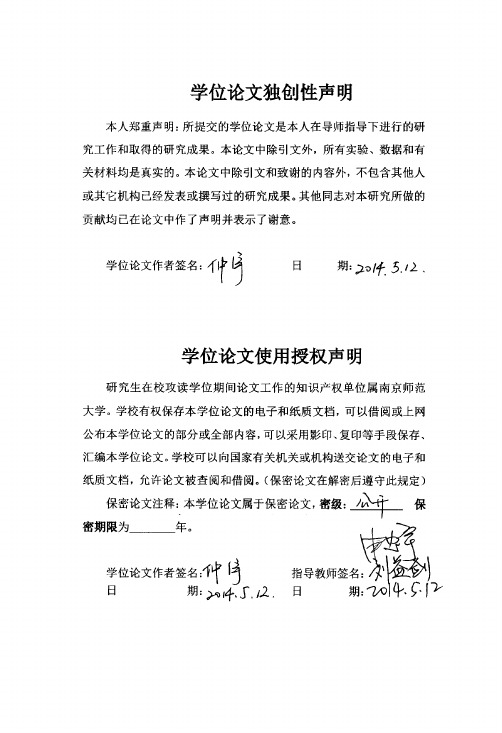
本人郑重声明:所提交的学位论文是本人在导师指导下进行的研 究工作和取得的研究成果。本论文中除引文外,所有实验、数据和有 关材料均是真实的。本论文中除引文和致谢的内容外,不包含其他人 或其它机构已经发表或撰写过的研究成果。其他同志对本研究所做的 贡献均己在论文中作了声明并表示了谢意。
第1章绪论……………………………………………………………………..1 1.1.1国外光伏发电系统的研究状况………………………………………1 1.1.2国内光伏发电系统的研究状况………………………………………2 1.2 MPPT控制器设计研究现状与分析……………………………………2 1.3课题研究意义与工作内容……………………………………………。4 l-3.1课题研究意义……………………………………………………4 1.3.2本文工作内容……………………………………………………4
Then with the features of improved algorithm and the performance requirements
of laboratory photovoltaic power generation system,the MPPT controller is designed carefully based on DSP chip.According to DSP’S own characteristics and input and output requirements,the main control circuit,the power circuit and the driver isolation circuit are described in details about the hardware part.On software part,
基于MPPT控制的光伏发电系统设计_本科毕业设计(论文)

本科毕业设计论文基于MPPT控制的独立光伏发电系统设计摘要随着时代的发展,人类对能源的需求越来越多,新能源开发是解决能源问题的根本途径,而太阳能光伏发电正是新能源和可再生能源的重要组成部分。
本文主要研究独立光伏发电系统,它有着相当广泛的应用。
独立光伏系统主要包括了光伏电池、蓄电池组、充电器和逆变器四个组成部分,本文对独立光伏系统中的最大功率点跟踪进行深入研究。
本文利用光伏电池的数学模型和等效电路,在MATLAB/Simulink中建立了光伏电池的仿真模型,得到了与实际光伏电池输出特性一致的仿真曲线,为进一步研究最大功率点跟踪打下了基础。
最大功率点跟踪的方法有很多,但是应用最为广泛的是扰动观察法和电导增量法,本文对自适应占空比干扰法进行了详细的分析,给出了算法设计,并建立了光伏电池的仿真模型对算法进行了仿真,仿真结果验证了算法设计的正确。
关键词:独立光伏系统,光伏电池,最大功率点跟踪The Design of Independent Photovoltaic Power Generation System Based on MPPT ControlABSTRACTWith the development of economics and technology, more and more energy is required. Researching and developing new energy is the radical method to resolve the energy problem, and the solar energy is the important composing of the new energy and the renewable energy.Research on the stand-alone photovoltaic system is the main content of this thesis. There is very comprehensive application for the stand-alone photovoltaic system. The stand-alone photovoltaic system is composed of the solar cell, storage battery, charger and inverter. Several key techniques, for instance , the MPPT(Maximum Power Point Tracking) are deeply studied in this thesis. Base on the mathematical model and the equivalent circuit, the solar cell simulation model in MATLAB/Simulink is built in order to research the MPPT, and the curve which is in accordance with the actual solar cell is attained. This work built the base for the further research on MPPT. There are many methods for MPPT, but the P&O(Perturb and Observe) method and the C.I. (Conductance incremental) method are applied most extensively, and these two methods are analyzed in detail. The algorithmic designs of the P&O method and the C.I. method are given in this thesis, and the algorithmic designs are simulated with the model of the solar cell in MATLAB/Simulink, and the result of simulation validated the correctness of the design of the two algorithms. Besides, take the P&O for instance, the factors which can affect the quality of the MPPT are discussed.KEY WORDS:Stand-alone photovoltaic system,Solar cell,MPPT目录前言 (1)第1章绪论 (2)1.1 发展光伏发电的意义 (2)1.1.1 保护气候和改善环境 (2)1.1.2 节省空间 (3)1.1.3 增加就业 (3)1.1.4 提供农村电力 (3)1.1.5 中国的特殊需求 (4)1.2 国内外光伏产业的发展及趋势 (4)1.2.1 世界光伏产业发展的现状和趋势 (4)1.2.2 国内光伏产业发展现状和趋势 (5)第2章光伏发电系统 (6)2.1 光伏发电系统的基本组成 (6)2.2 带有最大功率跟踪功能的光伏发电系统的基本组成 (6)第3章光伏阵列特性及其仿真模型的研究 (8)3.1 光伏电池的工作原理 (8)3.2 光伏电池等效电路分析 (9)3.3 光伏阵列的Simulink模型 (12)第4章光伏阵列最大功率点跟踪算法的研究 (18)4.1 光伏系统最大功率跟踪的原理 (18)4.2 最大功率跟踪点方法概述 (19)4.3 DC/DC变换电路实现MPPT的原理 (27)4.3.1 Boost变换电路 (28)4.3.2 Boost电路实现光伏阵列MPPT的仿真模型 (30)4.4 自适应占空比干扰观察法 (35)4.4.1 占空比干扰观察法的提出 (35)4.4.2 自适应控制技术介绍 (36)4.4.3 基于自适应控制思想的MPPT方法 (36)4.4.4 光伏阵列MPPT仿真模型的建立 (39)4.4.5 仿真结果与分析 (40)结论 (43)谢辞 (45)参考文献 (46)外文资料翻译 (49)前言长期以来,人们就一直在努力研究利用太阳能。
基于MPPT技术的家用太阳能光伏发电系统的研究

Specialty Name
: Power Electronics and Power Drives : Ren Hui (Signature) (Signature)
Instructor : Cai Wenhao
ABSTRACT
Nowadays conventional energy crisis and the environmental pollution have become increasingly prominent. To develop other renewable energy sources, such as solar, has become a consensus among the countries of the world, which also makes the solar photovoltaic industry develop more rapidly in recent years. It not only can reduce the environmental pollution, but also can meet the demand for electricity for the families which are far away from urban area and without electricity or lack of electricity to develop the solar photovoltaic power generation. At present, trend of the independent photovoltaic power generation system into the families also develops more quickly. The solar photovoltaic power generation system for the families is researched and designed in this paper. Firstly, the output characteristics of the solar cells are simulated on the basis of its working principles. The principle of maximum power point tracking (MPPT) is explained according to the non-linear relationship of the output characteristics of the solar cells. Some commonly used maximum power point tracking (MPPT) algorithms are simulated, which are combined with DC-DC converter. A novel MPPT algorithm is presented by comparing the advantages and disadvantages of them. Then properties of the charge and discharge of the battery, which is used to store energy, are researched. After that the capacity of it is calculated according to the requirements of the load. The former circuit uses the Boost converter to charge up the battery. Secondly, taking the low voltage level of the battery into account and in order to output 220V AC, the structure of “push-pull boost circuit + full-bridge inverter” is used finally through the analysis of several topology structures to improve the efficiency of the whole system. Design of the whole system includes both hardware and software. Selection of the parameters of each component、design of the high frequency transformer and its control
基于模糊控制的光伏发电系统MPPT设计

(7 )
式中 :(NB )表 示 负 大 、(N S )负 小 、(ZE ) 零 、(PS ) 正 小 、
(PB )正大 。 将输 入 、输 出论 域规 定 为 - 6 ~ 6 。 实 际 值 的
变化不在规定范围内 ,可通过量化因子把它们分别划归到
模糊论域中 [6] 。
图 2 模糊控制下的隶属度函数
式 中 :P( n) 和 U ( n) 分 别表 示 光伏 阵 列第 n 次采 样的输
出 功 率和 电 压值 。输 出量 为 n 点的 占 空比 增 量 d D 。
4 .2 输入输出量模糊子集与论域确定
设计将输入功率偏差 E 和偏差斜率 CE 以及输出量
d D 分别分成 5 个模糊子集 ,即 :
E = C E = d D{NB ,N S ,ZE ,PS ,PB}
1引言
能源和环保是目前人类关注的热点问题 。 为了缓解 能源危机 、保护生存环境 ,人类开始开发利用清洁 、环保的 可再生能源 [1] 。 光伏发电是太阳能利用的一种主要形式 , 其特点是安全 、环保 、不枯竭 。 但由于光伏发电效率低 、成 本高 ,因此到目前为止没能广泛应用 。 为了提高光伏发电 效率 ,国内外电光伏专家分别从对光伏阵列最大功率点的 跟踪方法及采用高频链逆变器等方面进行深入研究 。 光 伏阵列输出具有非线性特征 ,使光伏电池输出功率在一定 的工况下存在最优点 ,并且随着光照和温度参数的改变 , 最优工作点也会随着改变 。 为了能一直获得最大输出功 率 ,光伏发电系统必须进行最大功率点的跟踪 (maximum
4 .4 模糊规则 本设计根据功率偏差 E ,偏差斜率 CE 来决定当前输
出占空比的增量 ,通过分析光伏电池输出 P‐U 曲线 ,考虑 其他外界因素影响 ,可以得到 M PP T 控制的规则如下[7] 。
基于mppt技术的光伏充放电系统设计

HEBEINONGJI摘 要:本文对最大功率点跟踪技术进行深入的研究,根据其输出的非线性关系选择一个最大功率点跟踪的方法,从而设计了 一款基于MPPT (Maximum Power Point Tracking)技术的光伏充电系统,对提高能源的利用率具有非常重要 的意义。
本论文设计主要由光伏电池模型、DC/DC 控制器、MPPT 控制器、蓄电池、四部分组成。
结合DC/DC 变换器对常用MPPT 算法进行仿真。
本文DC/DC 控制电路选择前级升压后级降压的电路对蓄电池进行控制,然后在MAT LAB-Simulink 建立光伏电池仿真模型,进行实验测试证明本设计的合理性,满足设计需求。
关键词:最大功率点跟踪;DC/DC 控制器;Madab ;蓄电池基于MPPT 技术的光伏充放电系统设计青岛恒星科技学院姜珊 徐耀婷 郭金升 李花 朱霄霄1总体方案设计太阳能电池板的造价成本随着时代的发展越来越低,相应的安装成本也变得越来越少,这将大大有利于太阳能充电的普及。
随着人类生产技术的不断提高,对太阳能发电效率的转换也在不断提高叫本文所提及的最大功率点跟踪(MPPT)技 术的充电系统比普通的太阳能充电系统能多产出大约50%的电量,虽然会受到温度天气等环境的影响但是最后通过测试 还是会提高20%〜30%叫从这一方面来看,推广MPPT 技术光伏充电系统必定会 成为一种趋势。
20世纪80年代日本学者提出恒定电 压法,这是MPPT 算法中最为简单的一种。
将光伏阵列的输出电压保持在一个恒定的电压值,当外界的光照温度等外界环境发生改变时不能自动追踪到最大功率点珥当输出最大功率时,系统电压值和开路电压 大致成正比,关系表达式如下:U m «KxVoc (1-1)式中V qc 系统开路电压值; K ——比例系数(取0.75-0.8);U m 一系统输出最大功率时的电压 值。
恒定电压法优点是能够避免系统出现震荡,相比较来说较稳定,可靠性高,操作控制简单方便叫容易实现。
毕业实践报告论文--光伏发电系统

****************学院毕业生综合实践报告(论文)《太阳能光伏发电系统》学校:***********系别:*******班级:******姓名:******学号:*********指导教师:**********太阳能光伏发电系统摘要:太阳能是一种大有前途的新型能源,具有永久性、清洁性和灵活性三大优点。
太阳能电池寿命长,只要太阳存在,太阳能电池就可以一次投资而长期使用;与火力发电、核能发电相比,太阳能电池不会引起环境污染;光伏发电系统可以大中小并举,大到百万千瓦的中型电站,小到只供一户用的太阳能电池组,而且还缓解了目前能源危机与环境危机,这是其它电源无法比拟的。
关键词:太阳能,光伏发电,能源,环境。
Solar photovoltaic power generation system Abstract:Solar energy is a promising new type of energy, with a permanent, clean and flexible three major advantages. Solar battery life, as long as there is sun, solar cells can be an investment and long-term use , compared with thermal power, nuclear power, solar cells will not cause environmental pollution . Photovoltaic power generation system can be both medium and small, medium large million-kilowatt power plant, only a small battery pack with solar, but also ease the current energy crisis and environmental crisis, which is unmatched by other power.Key word : Solar energy , photovoltaic power generation , energy , environment.正文:我国能源总储量在世界上只是中等水平,这也决定了自我生产的力度很可能会造成个别关键的传统能源的迅速枯竭,石油、天然气人均可采储量仅有世界平均水平的7.7%和7.1%,储量比较丰富的煤炭只有世界平局水平的58.5%。
基于神经网络的光伏系统MPPT控制算法设计

基于神经网络的光伏系统MPPT控制算法设计吕晨旭【摘要】提出一种基于人工神经网络(ANN)的最大功率点跟踪(MPPT)控制算法.该算法通过扰动和观察(P&O)方法获得人工神经网络模型所需的参数,并分为离线和在线两种模式:离线模式通过测试神经网络参数,找到最佳的网络结构、激活函数和训练算法;在线模式实现优化人工神经网络以便应用于光伏系统.人工神经网络的输入变量为输出功率参数和电压参数,输出变量为归一化的增加或者减少占空比(+1或者-1).通过Matlab/Simulink模型对所提跟踪算法的性能进行测试验证,结果显示所提算法表现出良好的动态响应速度和稳态控制精度.%A maximum power point tracking (MPPT) control algorithm based on artificial neural network (ANN) is pro-posed. The algorithm can obtain the parameters needed by the ANN model by means of perturbation and observation (P&O) method. It includes the offline mode and online mode. The former mode can find the optimal network structure,activation func-tion and training algorithm by testing the neural network parameters. The latter mode can optimize the ANN,and apply it to the PV system. The input variables of the ANN are taken as the parameters of the output power and voltage,and the output variable is normalized as the increased or decreased duty ratio(+1 or -1). The performance of the proposed tracking algorithm is tested with Matlab/Simulink model for verification. The results show that the algorithm has perfect dynamic response speed and high steady-state control accuracy.【期刊名称】《现代电子技术》【年(卷),期】2018(041)003【总页数】5页(P132-135,140)【关键词】人工神经网络;扰动与观测算法;光伏电池模型;MPPT控制;离线模式;在线模式【作者】吕晨旭【作者单位】国网忻州供电公司,山西忻州 034000【正文语种】中文【中图分类】TN711-34;TP2730 引言目前,光伏(PV)能量转换系统已经成为最重要的可再生能源系统之一。
基于STM32的MPPT光伏控制器设计
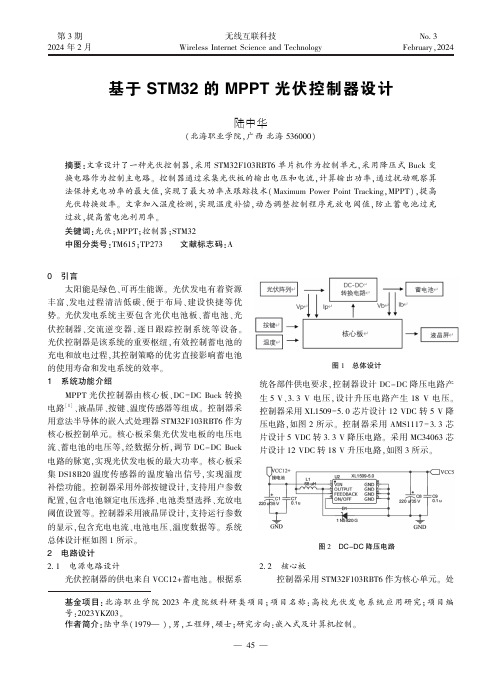
第3期2024年2月无线互联科技Wireless Internet Science and TechnologyNo.3February,2024基金项目:北海职业学院2023年度院级科研类项目;项目名称:高校光伏发电系统应用研究;项目编号:2023YKZ03㊂作者简介:陆中华(1979 ),男,工程师,硕士;研究方向:嵌入式及计算机控制㊂基于STM32的MPPT 光伏控制器设计陆中华(北海职业学院,广西北海536000)摘要:文章设计了一种光伏控制器,采用STM32F103RBT6单片机作为控制单元,采用降压式Buck 变换电路作为控制主电路㊂控制器通过采集光伏板的输出电压和电流,计算输出功率,通过扰动观察算法保持充电功率的最大值,实现了最大功率点跟踪技术(Maximum Power Point Tracking ,MPPT ),提高光伏转换效率㊂文章加入温度检测,实现温度补偿,动态调整控制程序充放电阈值,防止蓄电池过充过放,提高蓄电池利用率㊂关键词:光伏;MPPT ;控制器;STM32中图分类号:TM615;TP273㊀㊀文献标志码:A 0㊀引言㊀㊀太阳能是绿色㊁可再生能源㊂光伏发电有着资源丰富㊁发电过程清洁低碳㊁便于布局㊁建设快捷等优势㊂光伏发电系统主要包含光伏电池板㊁蓄电池㊁光伏控制器㊁交流逆变器㊁逐日跟踪控制系统等设备㊂光伏控制器是该系统的重要枢纽,有效控制蓄电池的充电和放电过程,其控制策略的优劣直接影响蓄电池的使用寿命和发电系统的效率㊂1㊀系统功能介绍㊀㊀MPPT 光伏控制器由核心板㊁DC -DC Buck 转换电路[1]㊁液晶屏㊁按键㊁温度传感器等组成㊂控制器采用意法半导体的嵌入式处理器STM32F103RBT6作为核心板控制单元㊂核心板采集光伏发电板的电压电流㊁蓄电池的电压等,经数据分析,调节DC -DC Buck电路的脉宽,实现光伏发电板的最大功率㊂核心板采集DS18B20温度传感器的温度输出信号,实现温度补偿功能㊂控制器采用外部按键设计,支持用户参数配置,包含电池额定电压选择㊁电池类型选择㊁充放电阈值设置等㊂控制器采用液晶屏设计,支持运行参数的显示,包含充电电流㊁电池电压㊁温度数据等㊂系统总体设计框如图1所示㊂2㊀电路设计2.1㊀电源电路设计㊀㊀光伏控制器的供电来自VCC12+蓄电池㊂根据系图1㊀总体设计统各部件供电要求,控制器设计DC -DC 降压电路产生5V㊁3.3V 电压,设计升压电路产生18V 电压㊂控制器采用XL1509-5.0芯片设计12VDC 转5V 降压电路,如图2所示㊂控制器采用AMS1117-3.3芯片设计5VDC 转3.3V 降压电路㊂采用MC34063芯片设计12VDC 转18V 升压电路,如图3所示㊂图2㊀DC -DC 降压电路2.2㊀核心板㊀㊀控制器采用STM32F103RBT6作为核心单元㊂处图3㊀DC -DC 升压电路理器的引脚分配如下:设计KEY1㊁KEY2识别外部按键,设计24C256_SDA㊁24C256_SCL 作为FM24C256存储器的通信I2C 接口,设计SWDIO㊁SWCLK 作为STM32的SWD 调试口,设计D1㊁D2控制IR2104的脉宽调制(Pluse Width Modulation,PWM)和使能,设计RXD3㊁TXD3作为程序固件升级,设计18B20_DQ采集外部温度,设计A0㊁A1采集太阳能板的电压电流,设计A2采集电池电压,设计DB0-DB7作为液晶屏的数据连接,设计RS㊁RW㊁E 分别实现液晶屏的数据/命令㊁读写㊁使能控制信号㊂处理器引脚分配如图4所示㊂图4㊀处理器引脚分配2.3㊀太阳能板输出电压和电流检测㊀㊀控制器采用ACS712电流传感器检测光伏板的输出电流,将检测的直流转换成比例的电压㊂IP +和IP -是该控制器的接线端子,电流从IP +流向IP -㊂VIOUT 为电流传感器的电压输出(标记A1)㊂利用电阻R10和R13实现Vp 的分压(标记A0),分别送入STM32的ADC 采样,进而获取光伏板的输出电流和电压㊂太阳能板电压电流检测如图5所示㊂图5㊀太阳能板电压电流检测2.4㊀DC -DC 半桥BUCK 电路设计和蓄电池电压检测㊀㊀DC -DC 半桥BUCK 电路采用IR2104芯片进行驱动控制,根据PMW 调整MOS 的导通和关闭,实现对电池的充电管理㊂STM32的控制信号D1接入IR2104的IN,实现PWM 控制㊂STM32另一个控制信号D2接入SD,实现使能控制㊂1N5819是自举二极管,C24㊁C26㊁C27是滤波电容,IR2104的HO 和LO 分别控制上下2个MOS 管,实现轮流工作,对12V蓄电池进行充电㊂蓄电池电压检测电路设计电阻R16㊁R17分压方式(标记A2),将蓄电池电压接入STM32,启动ADC 采样获取蓄电池电压㊂DC -DC 半桥BUCK 电路设计如图6所示㊂图6㊀DC -DC 半桥BUCK 电路设计2.5㊀按键和显示电路设计㊀㊀为实现程序上下翻页功能,外部按键电路采用KEY1㊁KEY2检测端口电平设计㊂当按键没有按下时,对应的电平处于高电平;当按键按下时,对应的电平被拉低㊂设计按键电路中的R27㊁R33保护IO 端口,设计电容C43㊁C44防止按键抖动㊂采用PC2004设计液晶显示电路,其使能控制端口E㊁读写控制RW㊁数据命令控制RS,分别由STM32的PC8-PC10端口编程控制,数据DB0-DB7由PC0-PC7编程控制㊂显示电路设计电阻R4㊁R5组成的分压电路为VO 用于调整屏幕对比度㊂按键和液晶显示如图7所示㊂图7㊀按键和液晶显示3㊀充电控制程序设计3.1㊀主程序设计㊀㊀采用集成开发环境Keil uVisionV5.27建立STM32嵌入式开发工程㊂控制器在系统上电后,初始化RCC㊁GPIO㊁ADC㊁TIM 等片内资源,启动ADC 定时采样并作数据处理,执行MPPT 程序控制和液晶显示等,如图8所示㊂图8㊀主程序流程3.2㊀最大功率点跟踪MPPT 程序设计㊀㊀采用扰动观察法的MPPT 控制算法[2-3]㊂该算法通过对比干扰周期前后太阳能光伏板的输出功率[1],读取ADC 转换结果得到对应的输出电压U 和电流I ,两者相乘得到当前输出功率Pn ,将Pn 与上一周期的输出功率Po 比较,如果Pn >Po ,则继续增大PMW 信号的占空比,否则减小占空比,扰动补偿设置为2[1]㊂在更新PWM 占空比后,保存新的输出功率值,更新输出PWM 脉冲信号㊂4㊀结果与分析㊀㊀本次实验以额定电压为18.4V㊁额定电流为5.75A 的光伏板作为光电转换设备,对额定电压为12V㊁120A 胶体电池进行充放电管理㊂为了保证光伏板输出始终在最大功率点运行,控制器实时监测光伏板的输出电压和电流,相乘得到功率值㊂MPPT 程序控制BUCK 电路调整PWM 以保证光伏板输出功率的最大值㊂在动态调整过程中,PWM 是非常关键的调制参数㊂采用万用表测试光伏板在占空比为10%~90%的PWM 信号下的输出电压和电流值及对应的输出功率,如表1所示㊂表1㊀不同PWM 数值的光伏板输出参数PWM /%U /V I /A P /W 1020.10.7014.072019.8 1.1021.783019.6 2.0039.204019.1 3.0959.0195018.5 4.9291.026018.0 5.58100.447016.3 5.6390.6288015.5 5.7088.359015.05.7186.65如表1所示,在一定的光照条件下,当PWM等于60%,光伏板的最大输出功率为100.44W,输出电压为18.0V,电流为5.58A㊂使用手持光照度探测仪作为校准设备,同等光照强度下,MPPT光伏控制器的工作状态的工作电压为18.2V,PWM为59%,功率为101W,与测试数据基本一致,表明本设计基本实现最大功率点跟踪㊂本文还测试了充放电阈值功能㊂本系统中,蓄电池过充保护电压设置为14.4V,蓄电池过放保护电压设置为10.8V,蓄电池浮充电压设置为13.7V,均能正确响应㊂另外,本控制器的温度补偿取值为30mV/ħ,随温度上升或下降分别调高或调低阈值㊂5 结语㊀㊀本设计采用STM32F103RBT6嵌入式处理器作为光伏控制器的核心㊂控制程序通过计算功率值,调整PWM脉冲信号的占空比,控制降压变换BUCK电路的开启和关断㊂该光伏控制器通过MPPT的扰动观察法实现光伏板的最大功率点追踪,提高了光伏发电系统的充电效率[4]㊂在充电管理程序中,通过增加温度补偿功能,动态调整充放电的阈值电压,提高蓄电效率,保护电池并延长电池使用寿命[4]㊂参考文献[1]胡雪花,李香服.基于MPPT的太阳能充电控制器设计与实现[J].山东工业技术,2023(1):27-33. [2]李正,马航.光伏发电MPPT恒压跟踪法优化研究[J].河南科技,2020(29):130-132.[3]李虹飞.基于优化MPPT算法的快速高效光伏充电控制器设计[J].山东农业大学学报,2021(2): 299-303.[4]张汉年,周望玮,徐开军.基于PIC单片机的光伏控制器设计[J].电子世界,2017(15):133-134.(编辑㊀王永超)Design of MPPT photovoltaic controller based on STM32Lu ZhonghuaBeihai Vocational College Beihai536000 ChinaAbstract This article designs a photovoltaic controller that uses the STM32F103RBT6microcontroller as the control unit and a buck converter circuit as the main control circuit.The controller collects the output voltage and current of the photovoltaic panel calculates the output power and maintains the maximum charging power through disturbance observation algorithm achieving Maximum Power Point Tracking MPPT technology and improving the photovoltaic conversion efficiency.This article also incorporates temperature detection to achieve temperature compensation dynamically adjust the charging and discharging threshold of the control program prevent overcharging and discharging of the battery and improve battery utilization.Key words photovoltaic MPPT controller STM32。
太阳能光伏发电系统设计毕业设计
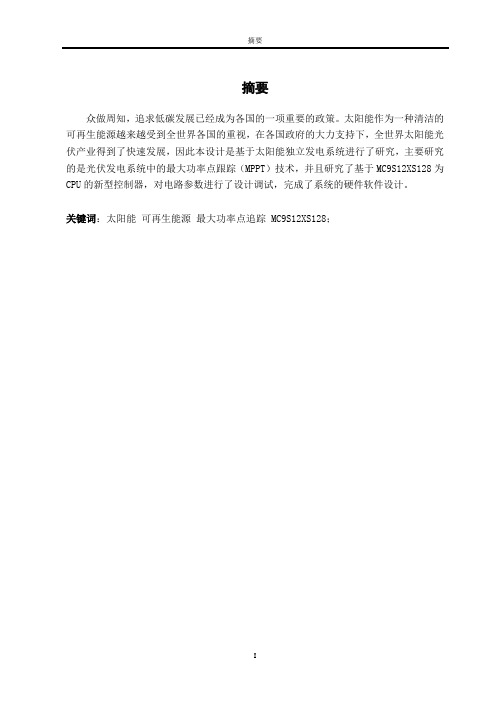
摘要摘要众做周知,追求低碳发展已经成为各国的一项重要的政策。
太阳能作为一种清洁的可再生能源越来越受到全世界各国的重视,在各国政府的大力支持下,全世界太阳能光伏产业得到了快速发展,因此本设计是基于太阳能独立发电系统进行了研究,主要研究的是光伏发电系统中的最大功率点跟踪(MPPT)技术,并且研究了基于MC9S12XS128为CPU的新型控制器,对电路参数进行了设计调试,完成了系统的硬件软件设计。
关键词:太阳能可再生能源最大功率点追踪 MC9S12XS128;AbstractAbstractAs you know ,the pursuit of low carbon development has become one of the important policies of every countries.Solar energy as a clean renewable energy has attracted world attention, in the strong support of governments, the world solar photovoltaic industry has developed rapidly, so the design is based on solar independent power system , the main research is the photovoltaic maximum power point tracking (MPPT) technology, and based on MC9S12XS128 is a new CPU controller, the circuit parameters are designed and debugging, completed the hardware and software design of the system.Keywords:Solar energy renewable energy maximum power point tracking MC9S12XS128;绪论第一章绪论1.1 太阳能光伏发电背景以及本设计的意义随着当今世界能源短缺以及化境污染问题的日益严重,可再生能源的发展引起了越来越高的重视,因此风能、核能、地热能、潮汐能以及太阳能等新能源的发展也成为了当今世界能源发展的重要利用对象。
光伏发电系统建模和仿真(毕业设计论文)

本科生毕业设计说明书(设计论文)题目:光伏发电系统建模及其仿真光伏发电系统建模及其仿真摘要伴随着能源危机和环境问题的不断加剧,清洁能源的发展进程被大大的推进了。
太阳能作为一种新能源以其没有污染,安全又可靠,能量随处可以得到等优点越来越受到人们的青睐。
无论从近期还是远期,无论从能源环境的角度还是从边远地区和特殊应用领域需求的角度考虑,太阳能发电都极具有吸引力。
那么对光伏发电系统的研究则就变得既有价值又有意义。
通过对光伏发电系统的理论研究学习,建立了完整的光伏发电系统体系,本文深入的研究了光伏电池在不同光照强度、不同温度下的电压、功率输出特性。
本文的研究重点是光伏发电系统的控制技术,以及在MATLAB/SIMULINK仿真环境下的仿真结果。
讨论了多种最大功率点跟踪方法;且分别讨论学习了在光伏并网和独立发电系统情况下的逆变器和MPPT的控制,并建立了仿真模型,提出了相应的控制策略。
且在最后论述了孤岛效应的产生和反孤岛策略,用电压频率检测法完成了孤岛检测与保护。
关键词:光伏电池,逆变器,最大功率点跟踪,孤岛效应, MATLAB仿真AbstractWith the growing energy crisis and environmental problems, clean energy is greatly promote the development process. Solar energy as a new kind of energy for its no pollution, safe and reliable, widely available energy advantages, such as more and more get the favor of people. No matter from the near future or long-dated and, no matter from the Angle of energy and environment, or from remote areas and special applications demand point of view, solar power generation is extremely attractive. So the study of photovoltaic power generation system has become both a rewarding and meaningful.Through the study of theoretical research of photovoltaic power generation system, established a complete system of photovoltaic power generation system, this paper in-depth study the photovoltaic cells under different illumination intensity, temperature, voltage, power output characteristics.In this paper, the research emphasis is the control technology of photovoltaic power generation system, and the simulation results in MATLAB/SIMULINK environment. Discussed a variety of maximum power pointtracking methods; And, respectively, to discuss the study under the condition of independent power generation and photovoltaic (pv) grid system of the inverter with MPPT control, and established the simulation model, put forward the corresponding control strategy. And islanding is discussed at the end of the production and the reverse island strategy, using frequency voltage tests completed island detection and protection.Keywords: photovoltaic batteries, inverter, maximum power point tracking, islanding, the MATLAB simulation目录摘要 (I)Abstract........................................................... I I 第一章绪论. (1)1.1新能源发电的背景和意义 (1)1.2光伏产业的现状和前景 (2)1.2.1太阳能光伏发电的发展现状 (2)1.2.2光伏发电产业的前景 (4)1.3本文设计容 (5)第二章光伏发电系统概述 (6)2.1光伏发电系统的基本工作原理 (6)2.2光伏发电系统的组成 (7)2.3光伏发电系统的分类 (8)2.3.1太阳能独立光伏发电系统 (8)2.3.2 并网光伏发电系统 (9)2.3.3互补型光伏发电系统 (12)第三章光伏发电系统建模及其仿真 (13)3.1光伏电池阵列的建模 (13)3.1.1 光伏电池阵列的数学模型 (13)3.1.2 光强和温度对光伏电池输出结果的影响 (16)3.1.3太光照强度模型 (18)3.2光伏发电系统的主电路模型 (19)3.2.1光伏并网发电系统的主电路模型 (20)3.2.2离网型光伏发电系统的主电路的模型 (21)第四章光伏发电系统的控制技术 (22)4.1光伏发电MPPT技术 (22)4.2电导增量法 (24)4.2.1电导增量法的原理 (24)4.2.2电导增量法改进 (27)4.3 最大功率控制技术仿真 (29)4.4光伏并网发电系统的控制 (33)4.4.1并网逆变器控制 (33)4.4.2 电流环的分析建模 (36)4.4.3锁相环的原理分析 (38)4.5离网光伏发电系统的控制 (41)4.5.1 光伏充电控制分析 (41)4.5.2独立光伏发电系统的逆变器控制技术 (46)第五章光伏并网系统中的孤岛效应 (49)5.1孤岛效应的分析和危害 (50)5.2 孤岛效应的检测 (50)5.2.1孤岛检测标准 (50)5.2.2孤岛检测方法 (52)结论 (57)展望 (58)参考文献 (60)致 (62)第一章绪论1.1新能源发电的背景和意义能源一直是人类社会生存和发展的动力和源泉。
光伏发电系统MPPT数字控制器设计

光伏发电系统MPPT数字控制器设计张杰;王宏华【摘要】利用MSP430微控制器设计了一种光伏发电系统最大功率点跟踪(MPPT)控制器,给出了较为详细硬件设计方案,包括DC-DC变换器电路设计、检测与控制电路设计、电源电路设计.最后给出了软件设计的总体流程图.%This paper designs a kind of maximum power point tracking (MPPT) controller of photovoltaic generation system with a MSP430 microcontroller,gives out the hardware design scheme in detail,including the designs of the DC-DC converter and detection,control,and power supply circuits,and the overall flow chart of the software design.【期刊名称】《机械制造与自动化》【年(卷),期】2013(042)004【总页数】5页(P164-167,171)【关键词】光伏发电;MSP430单片机;最大功率点跟踪【作者】张杰;王宏华【作者单位】河海大学能源与电气学院,江苏南京210098;河海大学能源与电气学院,江苏南京210098【正文语种】中文【中图分类】TH12;TK510 引言太阳能是一种用之不竭、储量巨大的清洁可再生能源,每天到达地球表面的辐射能量相当于数亿万桶石油燃烧的能量,太阳能开发与利用正逐步成为各国政府重点发展的战略。
“光伏发电”是利用光伏电池的光伏效应将太阳光的光能直接转换为电能的一种可再生、无污染的发电方式,正在全球范围内迅猛发展,其不仅要替代部分化石能源,而且未来将成为世界能源供应的主体,是世界各国可再生能源发展的重点[1]。
基于MPPT的光伏并网逆变器的设计

基于MPPT的光伏并网逆变器的设计基于MPPT的光伏并网逆变器的设计光伏发电作为一种清洁、可再生的能源形式,在全球范围内得到了广泛应用和推广。
光伏并网逆变器作为将直流电转换为交流电、实现光伏发电与电网连接的关键设备,具有极为重要的作用。
为了提高光伏发电系统的效率和输出功率,许多研究人员致力于设计高效率的光伏并网逆变器。
本文将介绍基于最大功率点追踪(Maximum Power Point Tracking,简称MPPT)的光伏并网逆变器的设计原理和关键技术。
MPPT技术是一种能够确保光伏发电系统以最佳工作点运行的技术。
光伏电池的输出功率与其输入电压和电流之积有关,光照强度和温度等因素会导致光伏电池的最大功率点发生变化。
通过MPPT技术,可以动态调整光伏电池的工作点,使其工作在最大功率点处,提高光伏发电系统的输出功率,充分利用太阳能资源。
基于MPPT的光伏并网逆变器的设计需要考虑多个方面的因素。
首先,需要选择合适的MPPT算法。
目前常用的MPPT算法包括脉宽调制(Pulse Width Modulation,简称PWM)控制、离散递推(Perturb and Observe,简称P&O)算法、增量电阻法等。
每种算法都有其特点和适用范围,设计者需要根据实际应用情况选择合适的算法。
其次,设计者需要选择合适的光伏电池模型。
光伏电池的电特性复杂,需要建立准确的模型来描述其电流与电压之间的关系。
常用的光伏电池模型有单二极管模型、二二极管模型、三二极管模型等。
根据光伏电池的类型和特性,选择合适的模型是设计者的重要任务。
另外,设计者还需要考虑光伏并网逆变器的拓扑结构和功率电子器件的选择。
光伏并网逆变器主要有中心式逆变器和微逆变器两种结构,选择合适的结构取决于系统的容量、布置和安装条件等因素。
功率电子器件的选择也会直接影响系统的性能,如开关频率、开关损耗等。
常见的功率电子器件有IGBT、MOSFET等,设计者需要根据性能要求和经济性来选择合适的器件。
基于模糊控制的光伏发电系统MPPT设计_荆红莉
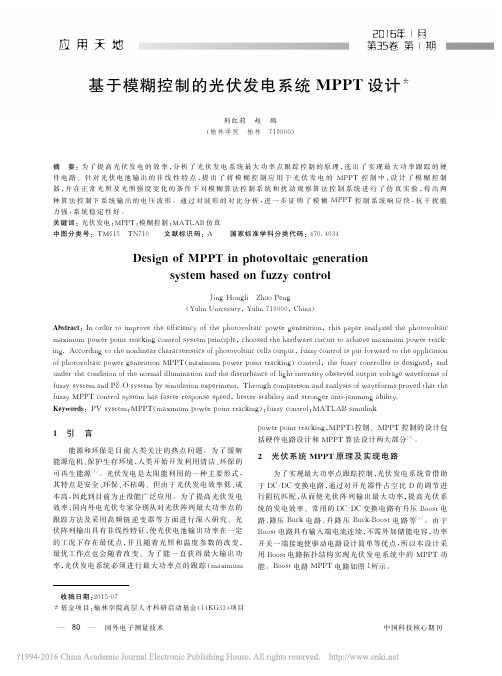
有 振 荡 、易 误 判 算法复杂 算法复杂、
需长时间训练
需历史经验
图 2 模 糊 控 制 下 的 隶 属 度 函 数
中国科技核心期刊
国外电子测量技术 — 81 —
4.3 隶 属 度 函 数 的 确 定 根据光伏电 池 的 输 出 特 性,考 虑 到 控 制 的 实 时 性,为 提
dD 分别分成5个模糊子集,即:
E=CE=dD{NB,NS,ZE,PS,PB}
(7)
式中:(NB)表 示 负 大、(NS)负 小、(ZE)零、(PS)正 小、
(PB)正大。将 输 入、输 出 论 域 规 定 为 -6~6。 实 际 值 的
变化不在规定范围内,可通过量化因子把 它们分别划归到
模糊论域中 。 [6]
power point tracking,MPPT)控制。MPPT 控制的设计包 括硬件电路设计和 MPPT 算法设计两大部分 。 [2]
2 光伏系统 MPPT 原理及实现电路
为 了 实 现 最 大 功 率 点 跟 踪 控 制 ,光 伏 发 电 系 统 常 借 助 于 DC/DC 变换电路,通过对开光 器 件 占 空 比 D 的 调 节 进 行阻抗匹配,从而使 光 伏 阵 列 输 出 最 大 功 率,提 高 光 伏 系 统的发电效率。常用的 DC/DC 变换电路有升压 Boost电 路、降压 Buck 电 路、升 降 压 Buck-Boost电 路 等 。 [2] 由 于 Boost电路具有输入端电流连续,不需外加储能电容,功 率 开关一端接地使驱动电路设计简单等优点,所 以本设计采 用 Boost电路拓扑结构 实 现 光 伏 发 电 系 统 中 的 MPPT 功 能。Boost电路 MPPT 电路如图1所示。
- 1、下载文档前请自行甄别文档内容的完整性,平台不提供额外的编辑、内容补充、找答案等附加服务。
- 2、"仅部分预览"的文档,不可在线预览部分如存在完整性等问题,可反馈申请退款(可完整预览的文档不适用该条件!)。
- 3、如文档侵犯您的权益,请联系客服反馈,我们会尽快为您处理(人工客服工作时间:9:00-18:30)。
本科毕业设计论文基于MPPT控制的独立光伏发电系统设计摘要随着时代的发展,人类对能源的需求越来越多,新能源开发是解决能源问题的根本途径,而太阳能光伏发电正是新能源和可再生能源的重要组成部分。
本文主要研究独立光伏发电系统,它有着相当广泛的应用。
独立光伏系统主要包括了光伏电池、蓄电池组、充电器和逆变器四个组成部分,本文对独立光伏系统中的最大功率点跟踪进行深入研究。
本文利用光伏电池的数学模型和等效电路,在MATLAB/Simulink中建立了光伏电池的仿真模型,得到了与实际光伏电池输出特性一致的仿真曲线,为进一步研究最大功率点跟踪打下了基础。
最大功率点跟踪的方法有很多,但是应用最为广泛的是扰动观察法和电导增量法,本文对自适应占空比干扰法进行了详细的分析,给出了算法设计,并建立了光伏电池的仿真模型对算法进行了仿真,仿真结果验证了算法设计的正确。
关键词:独立光伏系统,光伏电池,最大功率点跟踪The Design of Independent Photovoltaic Power Generation System Based on MPPT ControlABSTRACTWith the development of economics and technology, more and more energy is required. Researching and developing new energy is the radical method to resolve the energy problem, and the solar energy is the important composing of the new energy and the renewable energy.Research on the stand-alone photovoltaic system is the main content of this thesis. There is very comprehensive application for the stand-alone photovoltaic system. The stand-alone photovoltaic system is composed of the solar cell, storage battery, charger and inverter. Several key techniques, for instance , the MPPT(Maximum Power Point Tracking) are deeply studied in this thesis. Base on the mathematical model and the equivalent circuit, the solar cell simulation model in MATLAB/Simulink is built in order to research the MPPT, and the curve which is in accordance with the actual solar cell is attained. This work built the base for the further research on MPPT. There are many methods for MPPT, but the P&O(Perturb and Observe) method and the C.I. (Conductance incremental) method are applied most extensively, and these two methods are analyzed in detail. The algorithmic designs of the P&O method and the C.I. method are given in this thesis, and the algorithmic designs are simulated with the model of the solar cell in MATLAB/Simulink, and the result of simulation validated the correctness of the design of the two algorithms. Besides, take the P&O for instance, the factors which can affect the quality of the MPPT are discussed.KEY WORDS:Stand-alone photovoltaic system,Solar cell,MPPT目录前言 (1)第1章绪论 (2)1.1 发展光伏发电的意义 (2)1.1.1 保护气候和改善环境 (2)1.1.2 节省空间 (3)1.1.3 增加就业 (3)1.1.4 提供农村电力 (3)1.1.5 中国的特殊需求 (4)1.2 国内外光伏产业的发展及趋势 (4)1.2.1 世界光伏产业发展的现状和趋势 (4)1.2.2 国内光伏产业发展现状和趋势 (5)第2章光伏发电系统 (6)2.1 光伏发电系统的基本组成 (6)2.2 带有最大功率跟踪功能的光伏发电系统的基本组成 (6)第3章光伏阵列特性及其仿真模型的研究 (8)3.1 光伏电池的工作原理 (8)3.2 光伏电池等效电路分析 (9)3.3 光伏阵列的Simulink模型 (12)第4章光伏阵列最大功率点跟踪算法的研究 (18)4.1 光伏系统最大功率跟踪的原理 (18)4.2 最大功率跟踪点方法概述 (19)4.3 DC/DC变换电路实现MPPT的原理 (27)4.3.1 Boost变换电路 (28)4.3.2 Boost电路实现光伏阵列MPPT的仿真模型 (30)4.4 自适应占空比干扰观察法 (35)4.4.1 占空比干扰观察法的提出 (35)4.4.2 自适应控制技术介绍 (36)4.4.3 基于自适应控制思想的MPPT方法 (36)4.4.4 光伏阵列MPPT仿真模型的建立 (39)4.4.5 仿真结果与分析 (40)结论 (43)谢辞 (45)参考文献 (46)外文资料翻译 (49)前言长期以来,人们就一直在努力研究利用太阳能。
我们地球所接受到的太阳能,虽只占太阳表面发出的全部能量的二十亿分之一左右,但是这些能量相当于全球所需总能量的3—4万倍,可谓取之不尽,用之不竭。
太阳能和石油、煤炭等矿物燃料不同,不会导致“温室效应”和全球性气候变化,也不会造成环境污染。
特别是在近10多年来,在石油可开采量日渐见底和生态环境日益恶化这两大危机的夹击下,太阳能的利用受到许多国家的重视,大家正在竞相开发各种光电新技术和光电新型材料,以扩大太阳能利用的应用领域。
从发电、取暖、供水到各种各样的太阳能动力装置,其应用十分广泛,在某些领域,太阳能的利用已开始进入实用阶段。
电能是目前使用最广泛的能源利用形式,光电转换在太阳能的引用领域中占有重要的地位,太阳能电池就是一种经由太阳光照射后,把光的能量转换成电能的能量转换元件。
有人称之为光伏电池光伏系统。
目前的主要问题是电池的转换效率低且价格昂贵,因此,如何在现有的光电元件转换技术的基础上,进一步提高太阳电池的转换效率,充分利用光伏阵列所转换的能量,一直是光伏系统研究的重要方向。
本课题从太阳能电池的光伏特性出发,对于如何提高太阳能电池的能量转换效率,进行了有益的探讨。
第1章绪论1.1 发展光伏发电的意义太阳能作为一种可持续利用的洁净能源,有着巨大的开发应用潜力。
人类赖以生存的自然资源几乎全部转换自太阳能,人类利用太阳能的历史更是可以追溯到人类的起源时代。
太阳能是人类得以生存和发展的最基础的能源形式,从现代科技的发展来看,太阳能开发利用技术的进步有可能决定着人类未来的生活方式。
目前,虽然太阳能光伏发电成本较高,但是从长远来看,随着技术的进步,以及其它能源利用形式的逐渐饱和,太阳能可能在2030之后成为主流能源利用形式,有着不可估量的发展潜力。
光伏发电着有许多特殊优势,尤其是它可以为边远地区、特殊场合供电。
考虑到光伏发电的附加价值,它的综合经济效益大大提升,因此不能单纯与传统发电模式去比较单位发电成本。
光伏发电可以降低温室气体和污染物排放、创造就业机会、保障能源安全和促进农村尤其是边远农村的发展。
总之,发展光伏发电在经济、社会和环境保护等方面都有着积极的意义,下面来具体讨论光伏发电的发展意义。
1.1.1 保护气候和改善环境太阳能光伏发电最重要的特征是在发电过程中只排放很少的CO2,而CO2作为最主要的温室气体,导致气候变化的罪魁祸首。
同时,电池板可循环使用,系统材料可再利用,光伏的能源投入可进一步降低。
如果广泛使用光伏发电技术,可以为减缓气候变暖做出贡献。
我国能源消费占世界的10%以上,同时我国一次能源消费中,煤占到70%左右,比世界平均水平高出40多个百分点。
燃煤造成的二氧化硫和烟尘排放量约占排放总量的70%~80%,二氧化硫排放形成的酸雨面积已占国土面积的1/3。
目前,环境质量的总体水平还在不断恶化,世界十大污染城市我国一直占多数。
环境污染给我国社会经济发展和人民健康带来了严重影响。
世界银行估计2020年中国由于空气污染造成的环境和健康损失将达到GDP总量的13%。
而光伏发电不产生传统发电技(例如燃煤发电)带来的污染物排放和安全问题,没有废气或噪音污染。
系统报废后也很少有环境污染的遗留问题[1,2]。
1.1.2 节省空间光伏发电是一种简单的低风险技术,几乎可以安装在任何有光的地方。
这意味着在公共、私人和工业建筑的屋顶和墙面上都有广泛的安装潜力。
在运行中,这个系统还可以降低建筑的受热,增加通风。
光伏电池板还可以作为隔声板装在公路两侧。
光伏发电在提供大量电力供应的同时,避免占用更多的土地。
1.1.3 增加就业光伏发电可以提供大量的就业机会。
安装阶段创造大量的就业机会(安装工人、零售商和服务工程师),促进地方经济发展。
根据欧洲光伏发电行业信息显示,生产每兆瓦光伏产品大约产生10个就业机会,安装每兆瓦光伏系统创造大约33个就业机会。
批发和间接供应可提供3~4个就业岗位,研究领域提供1~2个就业机会。
整个产业链中,每兆瓦的生产、安装和使用,可提供50个就业机会。
在未来几十年,随着规模的扩大,自动设备的使用,这些数据会有所降低。
